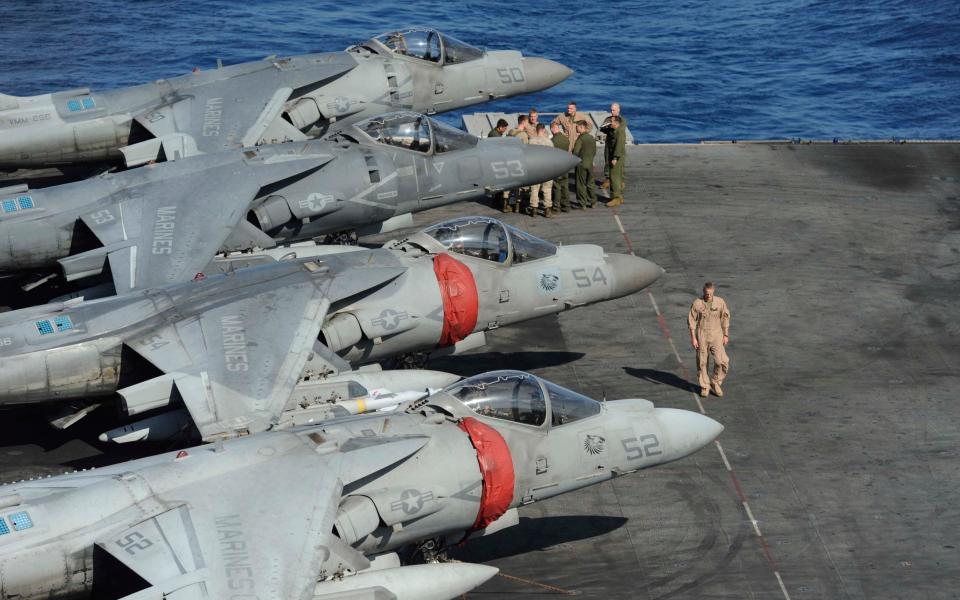China’s new ‘big deck’ invasion ship may have catapults. It’s one to watch

A shipyard in Shanghai is making solid progress on the first vessel in a new class of amphibious assault ship for the Chinese navy. The 830-foot Type 076 assault ship appears to have a full-length flight deck and may have an electromagnetic aircraft catapult and arrestor wires – like an aircraft carrier, but smaller.
Countries with these “big-deck” amphibs tend to use them primarily for carrying out landings of troops from the sea. They carry assault and attack helicopters on their flight decks, and landing craft and amphibious armoured vehicles in their internal well decks. The helicopters land marines from the air at the same time the landing craft and vehicles land marines from the sea. America’s big-deck amphibs, which are as big as some countries’ full-sized aircraft carriers, carry Osprey tiltrotors and vertical-thrust Harrier or F-35B jump jets as well as helicopters.

In a pinch, big-deck assault ships can also double as “light” aircraft carriers – provided they have suitable aircraft. The Type 076 will, at the very least, be a formidable addition to the Chinese navy’s growing amphibious flotilla. And it just might bolster China’s carrier air power, too.
The Chinese navy already has three Type 075 big-deck amphibs and is building at least one more. The big difference between the Type 075 and the future Type 076 is the latter’s possible catapult and arrester wires. Steam-powered or electromagnetic catapults help carriers launch heavy fixed-wing aircraft in a short distance. Wires help them land in a short distance.
The Type 076’s specifications specifically mention unmanned aerial vehicles, possibly indicating the Chinese navy plans to equip the class with one or more of the many armed drone types Chinese industry is developing for the People’s Liberation Army, Navy and Air Force.
That would make sense. The Chinese navy is already building, at a river shipyard near Shanghai, an experimental drone-carrier that could help the fleet develop technology and tactics for the Type 076s.
It’s unlikely the Type 076s will operate the Chinese fleet’s existing and in-development manned carrier aircraft. They include the Shenyang J-16 fighter, the Shenyang J-35 stealth fighter, the Shenyang J-16D radar-jamming jet and the Xi’an KJ-600 early-warning plane.
The lightest of these types, the J-16, is barely compatible with China’s first two flattops – the Soviet-inspired Liaoning and Shandong, both around 1,000 feet long and equipped with arrester wires but no catapults. To be able to take off from these ships’ “ski-jump” ramps, the J-16s must get up to flying speed under their own power. This means they must take off with only partial loads of fuel and weapons.
It’s telling that the Chinese navy has devoted enormous resources to building a third carrier, the 1,040-foot Fujian, that boasts a much wider flight deck plus catapults.
Fujian, which set sail from Shanghai for sea trials last month, is optimized for J-16s, J-35s, J-16Ds and KJ-600s. If an 830-foot Type 076 could embark China’s new carrier air wing, Fujian might’ve been redundant.
But if the Chinese navy ever develops a vertical-thrust jump jet in the class of the Boeing AV-8B Harrier or Lockheed Martin F-35B, the Type 076s might do more than carry drones. They could become true light carriers, as American amphibs sometimes do.
The US Navy operates nine big-deck assault ships that normally embark six or so US Marine Harriers or F-35Bs. Launching after a short take-off run and landing vertically, the jump-jet fighters are primarily intended to provide close air support to beach-storming Marines. However they can instead be armed as air-to-air fighters, and protect the ship against attacking aircraft or drones.
The US Navy and US Marines have demonstrated the ability to transform the assault ships into light carriers by reducing their helicopter complements and adding more fighters. During the US-led invasion of Iraq in 2003, four assault ships each embarked up to 20 Harriers in order to contribute to the coalition air campaign.
In 2019, the improved assault ship USS America set sail across the Pacific Ocean with no fewer than 13 F-35Bs aboard. Three years later, America embarked 16 F-35Bs, working toward a theoretical maximum of 20 of the stealthy jump jets.
For years, there have been rumours that China is developing its own jump jet. For years, there’s been no actual hard evidence of this purported F-35B-like warplane. If these rumors prove true and a Chinese jump jet ever takes flight, the Chinese navy’s carrier fleet could – by a certain definition – instantly grow by potentially several vessels.
China’s navy continues to grow, both in numbers and in new capabilities. And this latest development, strengthening as it does China’s ability to mount a seaborne invasion, will probably be watched very carefully in Taiwan.

 Yahoo News
Yahoo News 
